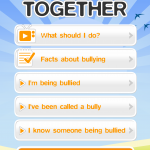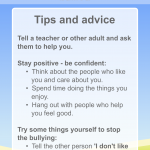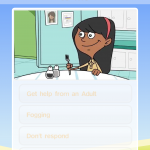Take a Stand Together offers users a deeper understanding of what bullying is, why it happens, and where it happens. The app uses interactive scenarios which allow users to think through what they would do if they were being bullied, were called a bully, or knew someone who was being bullied. Despite the lack of clarity around what age it is purposed for, this app could be used well to educate and prepare children, teens, and/or parents dealing with bullying.
Version: 1.2 (Android) 2.2 (IOS)
Compatibility: Available on iOS and Android devices
Price: Free
Target Audience: Practitioners working with children and teens being bullied or bullying their peers
Bottom Line: Take a Stand Together offers users an opportunity to identify and understand bullying and get help if they are being bullied.
Have you used the app? Rate it here![Total: 6 Average: 3.5]
Likes |
Dislikes |
|
|
Features and Options:
Take a Stand Together’s main features include interactive games, informational pages for those who are being bullied; have been called a bully; or know someone who has been bullied, and an informational page on ways to get help.
Interactive Games
Using the interactive games, the user can play out hypothetical bullying scenarios. After watching a bullying scenario, the user indicates what they think is the best way to respond. Their response determines the response of the app. For example, if the user chooses to “say something nasty back” to the bully, the app will explain the possible consequences of this response. This feature helps users understand the range of consequences of typical reactions to bullying. The feature also teaches children who bully, even unconsciously, how to identify what conduct constitutes bullying.
Educating Youth and Parents
By opening any of the informational pages, “Facts about bullying;” “I am being bullied;” “I’ve been called a bully;” and “I know someone being bullied,” the user is given the tools to label bullying they have seen or been a participant of. Each page offers different advice on topics like, how to stop bullying; how to help a friend who is being bullied; and how to know when you are bullying someone else. The information found on the app is likely to help youth and adolescents know bullying behavior and respond more appropriately.
Getting Help
All pages include a “GET HELP!” button. When the user clicks this button, they are directed to a new page which identifies who they might be able to talk to in their community. The app also offers the contact information for the “Kids Helpline” and the “Kids Helpline Website.” It should be noted, this app was developed in Australia, so these referrals are for Australian agencies. As only a small part of the app, the loss of this feature does not deplete the whole app of its value.
The app’s features are colorful and loud, making it seem as if the app is geared towards young children, but some of the situations and language appear appropriate only for teens. Thus, it is unclear whether this app was created for an elementary, middle school, or high school audience. Though many of the app functions have a clear purpose, the “Create an Avatar” feature does not. This function seems mostly for the user’s entertainment, and beyond this, the utility of this feature is unclear.
Practice Implications
This app could be used by practitioners working with youth and adolescents to educate them about bullying and how to respond when they are bullied, know someone being bullied, or have been called a bully. A practitioner could complete the interactive portions of this app with their clients, discussing the effective ways to respond to bullying. Also, this app could be referred to parents, as a way to initiate conversations about bullying with their children.





